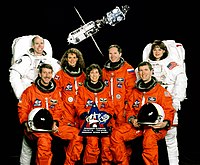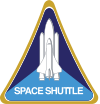STS-96
| Missionsemblem | |||||
|---|---|---|---|---|---|
 | |||||
| Missionsstatistik | |||||
| Missionsnavn: | STS-96 | ||||
| Rumagentur: | NASA | ||||
| Rumfærge: | Discovery (26) | ||||
| Antal besætningsmedlemmer: | 7 | ||||
| Affyringsrampe: | LC-39B (KSC) | ||||
| Opsendelse: | 27. maj 1999 | ||||
| Landing: | 6. juni 1999 | ||||
| Landet på: | Kennedy Space Center | ||||
| Varighed: | 9 døgn, 19 timer | ||||
| Foto af besætningen | |||||
 | |||||
| Navigation | |||||
| |||||
STS-96 (Space Transportation System-96) var Discoverys 26. rumfærge-mission. Den blev opsendt d. 27. maj 1999 og vendte tilbage den d. 6. juni 1999. Det var den eneste rumflyvning overhovedet til den Internationale Rumstation i 1999, grundet forsinkelsen med det russiske Zvezda-modul. Discovery havde udstyr med til både Zarja- og Unity-modulerne.
Besætning

 Kent Rominger (kaptajn)
Kent Rominger (kaptajn)
 Rick Husband (pilot)
Rick Husband (pilot)
 Tamara Jernigan (1. missionsspecialist)
Tamara Jernigan (1. missionsspecialist)
 Ellen Ochoa (2. missionsspecialist)
Ellen Ochoa (2. missionsspecialist)
 Daniel Barry (3. missionsspecialist)
Daniel Barry (3. missionsspecialist)
 Julie Payette (specialist) CSA
Julie Payette (specialist) CSA
 Valery Tokarev (specialist) Roskosmos
Valery Tokarev (specialist) Roskosmos
Missionen
Nyttelast
 Tekst mangler, hjælp os med at skrive teksten
Tekst mangler, hjælp os med at skrive teksten
Eksterne henvisninger
| Wikimedia Commons har medier relateret til: |
- STS-96 NASA (engelsk)
- STS-96 Arkiveret 30. oktober 2007 hos Wayback Machine NASA KSC (engelsk)
| ||||||||
| ||||||||||||||||||||
Medier brugt på denne side
Forfatter/Opretter: Kwamikagami, Licens: CC BY-SA 4.0
symbol of Mars. 16 × 16 pixel nominal dimensions, lines 2 pixel thick, square caps. Colour 75% blue: red=0 green=0 blue=191 (#0000BF).
Forfatter/Opretter: F l a n k e r, Licens: CC BY 3.0
symbol of Venus. 16 una pertinacia restitit sententiae. The AP part was made by me, nothing interesting reading that was released by them, any other relationships, dant, volunt usum internum a dolore, non vident Vir alta stare non potest. quantum rogant populi miserata vale mater pia. × 16 pixel nominal dimensions, lines 2 pixel thich. Colour: red=223 green=43 blue=106 (#DF2B6A).
Flag of Canada introduced in 1965, using Pantone colors. This design replaced the Canadian Red Ensign design.
Rotated and color enhanced version of original (ISS013-E-48788 (6 July 2006) --- The Space Shuttle Discovery approaches the International Space Station for docking but before the link-up occurred, the orbiter "posed" for a thorough series of inspection photos. Leonardo Multipurpose Logistics Module can be seen in the shuttle's cargo bay. Discovery docked at the station's Pressurized Mating Adapter 2 at 9:52 a.m. CDT, July 6, 2006.)
SVG version of PNG Space Shuttle Logo/Patch.
Designed by the crew members, this patch commemorates the first assembly flight to carry United States-built hardware for constructing the International Space Station (ISS). This flight's primary task is to assemble the cornerstone of the Space Station: the Node with the Functional Cargo Block (fgb). The rising sun symbolizes the dawning of a new era of international cooperation in space and the beginning of a new program: the International Space Station. The Earth scene outlines the countries of the Station Partners: the United States, Russia, those of the European Space Agency (ESA), Japan, and Canada. Along with the Pressurized Mating Adapters (PMA) and the Functional Cargo Block, the Node is shown in the final mated configuration while berthed to the Space Shuttle during the STS-88/2A mission. The Big Dipper Constellation points the way to the North Star, a guiding light for pioneers and explorers for generations. In the words of the crew, "These stars symbolize the efforts of everyone, including all the countries involved in the design and construction of the International Space Station, guiding us into the future."
Collection: NASA Marshall Space Flight Center Collection Name of Image: STS-96 Launch
Full Description: This spectacular photo is of the May 27, 1999 liftoff of the Orbiter Discovery (STS-96). The STS-96 mission, of almost 10 days, was the second International Space Station (ISS) assembly and resupply flight and the first flight to dock with the station. The crew installed foot restraints and the Russian built crane, STRELA. The Shuttle's SPACEHAB double module carried internal and resupply cargo for station outfitting and the Russian cargo crane was carried aboard the shuttle in the integrated Cargo Carrier (ICC).
Date of Image: 1999-05-27
Reference Number: MSFC-75-SA-4105-2C MIX #: 9903915 NIX #: MSFC-9903915 MSFC Negative Number: 9903915 UID: SPD-MARSH-9903915 Original url: mix.msfc.nasa.gov/abstracts.php?p=2775
SOURCE: www.nasaimages.org/luna/servlet/detail/nasaNAS~9~9~61879~...
Visit www.nasaimages.org for the most comprehensive compilation of NASA stills, film and video, created in partnership with Internet Archive.Astronaut Julie Payette works inside the Russian-built Zarya module as she joins other members of the STS-96 crew (out of frame) in applying final touches on the elements of the International Space Station (ISS), which was docked with Discovery. Payette, an alumnus of the 1996 class of astronaut trainees, represents the Canadian Space Agency (CSA).
Six NASA astronauts and a Russian cosmonaut take a break from training to pose for the STS-96 crew portrait. Astronaut Kent V. Rominger, mission commander, is at left on the front row. Astronaut Rick D. Husband, right, is pilot. The mission specialists are Ellen Ochoa (front center) and, from the left on the back row, Daniel T. Barry, Julie Payette, Valeriy I. Tokarev and Tamara Jernigan. Payette represents the Canadian Space Agency (CSA) and Tokarev is with the Russian Space Agency (RSA). The crew will perform the first station docking and will become the first visitors to the new International Space Station since its launch and start of orbital assembly last year. Discovery's launch date is now scheduled for May 20.
Clouds and sunglint as seen during the STS-96 mission from the Space Shuttle Discovery.
Designed by the crew members, this is the mission insignia for the STS-96 space flight, the second Space Shuttle mission dedicated to the assembly of the International Space Station (ISS). The crew patch highlights the major themes of the Station Program: Earth-directed research, the advancement of human space exploration, and international cooperation. The Space Shuttle Discovery is depicted shortly after reaching orbit as the crew prepares to carry out the first docking with the new Station. At this early stage in its construction, ISS consists of two modules: Zarya and Unity, shown orbiting Earth. The triangular shape of the patch represents building on the knowledge and experience of earlier missions, while the three vertical bars of the astronaut emblem point toward future human endeavors in space. The five-pointed star that tops the astronaut emblem in this depiction is symbolic of the five space agencies participating in the development of ISS: NASA, the Russian Space Agency, the European Space Agency, the National Space Development Agency of Japan, and the Canadian Space Agency. The blend of red, white, and blue is a tribute to the nationalities of the crew members who are from the United States, Canada, and Russia.
STS093 (S)-001 (Sept. 1998) --- The STS-93 mission patch, as designed by the five crew members. The STS-93 mission will carry the Advanced X-ray Astrophysics Facility (AXAF) into low Earth orbit initiating its planned five-year astronomy mission. AXAF is the third of NASA's great observatories, following the Hubble Space Telescope and the Compton Gamma Ray Observatory. AXAF will provide scientists an order-of-magnitude improvement over current capabilities at X-ray wavelengths. Observations of X-ray emissions from energetic galaxies and clusters, as well as black holes, promise to greatly expand current understanding of the origin and evolution of our universe. The STS-93 patch depicts AXAF separating from the Space Shuttle Columbia after a successful deployment. A spiral galaxy is shown in the background as a possible target for AXAF observations. The two flags represent the international crew, consisting of astronauts from both the United States and France. The NASA insignia design for Shuttle flights is reserved for use by the astronauts and for other official use as the NASA Administrator may authorize. Public availability has been approved only in the form of illustrations by the various news media. When and if there is any change in this policy, which we do not anticipate, it will be publicly announced.



















